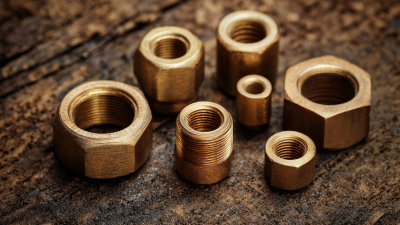Understanding the Challenges with Ppsu Pex Fittings in Modern Plumbing Solutions
In the evolving landscape of modern plumbing solutions, Ppsu Pex fittings have emerged as a significant player, offering enhanced durability and performance. According to recent industry reports, the global PEX market is expected to reach $2.24 billion by 2026, with Ppsu Pex fittings capturing a notable market share due to their superior resistance to heat, chemicals, and corrosion compared to traditional materials. These fittings not only facilitate easier installations but also promise a longer lifespan for plumbing systems, thereby reducing maintenance costs over time.

However, their adoption is not without challenges, as factors such as compatibility with existing systems and installation techniques can pose concerns for professionals in the field. Understanding these complexities is crucial for both plumbing experts and consumers looking to leverage the benefits of Ppsu Pex fittings in contemporary plumbing applications.
Identifying Common Issues with Ppsu Pex Fittings in Plumbing Systems
PPSU PEX fittings have gained popularity in modern plumbing systems due to their durability and resistance to high temperatures. However, they are not without challenges. One of the common issues identified with PPSU PEX fittings is the potential for leaks at connection points, particularly when subjected to thermal expansion and contraction. According to a recent technical report, improper installation techniques can exacerbate this issue, leading to costly repairs and system inefficiencies.

Another significant concern is the compatibility of PPSU PEX with various insulation materials. For instance, applying spray foam insulation around plastic pipes has become a common practice to improve energy efficiency. However, if not done correctly, it can lead to overheating in the fittings, weakening them over time. Industry data indicates that maintaining optimal thermal conditions is critical to prolonging the lifespan of plumbing systems, especially those utilizing PPSU PEX fittings. As plumbing solutions evolve, addressing these issues becomes paramount for ensuring reliability and performance in residential and commercial applications.
Evaluating the Longevity and Durability of Ppsu Pex Fittings
In the evolving world of plumbing solutions, PPSU (Polyphenylsulfone) PEX fittings have gained popularity for their ability to withstand extreme temperatures and resist chemical degradation. Evaluating the longevity of these fittings is critical, as long-lasting materials lead to enhanced system reliability. Unlike traditional fittings, PPSU PEX options boast an impressive lifespan, promising durability that can extend for decades under optimal conditions. Their resistance to hydrolysis and thermal degradation makes them a superior choice for both hot and cold water distribution systems.
Moreover, the durability of PPSU PEX fittings plays a crucial role in minimizing maintenance costs and preventing leaks that can lead to significant water damage. The impressive mechanical properties of PPSU also ensure that these fittings can handle the pressures of modern plumbing systems without failure. As more homeowners and contractors become aware of these advantages, the demand for high-performance plumbing solutions continues to rise. However, careful consideration must still be given to installation practices and environmental factors that can affect the overall system longevity, ensuring that the benefits of PPSU PEX fittings are fully realized.
Understanding the Challenges with Ppsu Pex Fittings in Modern Plumbing Solutions
This chart illustrates the estimated longevity of various plumbing fitting types. PPSU PEX fittings are compared to traditional materials, indicating their expected lifespan in years, which presents a challenge for their acceptance in modern plumbing solutions.
Expert Tips for Ensuring Proper Installation of Ppsu Pex Fittings
When it comes to modern plumbing solutions, proper installation of PPSU PEX fittings is crucial for maximizing performance and durability. PEX, a cross-linked polyethylene, is gaining popularity due to its flexibility and resistance to scale and chlorine, making it ideal for various plumbing applications. However, without the correct installation techniques, plumbing systems can face significant challenges, leading to leaks and potential water damage.
To ensure a successful installation, consider these expert tips: First, always use the appropriate tools designed for PEX installations, such as the latest PEX expander tools, which can save time and improve precision. For instance, the new expander tools with Rapid Seal heads allow for quick expansion and secure fittings, enhancing overall efficiency. Second, pay attention to temperature settings. PPSU PEX fittings can comfortably handle temperature variations, but extremes in heat or cold during installation can affect their integrity. Maintaining a stable environment during installation will contribute to better long-term performance of the plumbing system.
Finally, be mindful of the fitting connections. It’s advisable to inspect all connections for tightness and to ensure they are properly secured. Utilizing high-quality couplings will mitigate the risk of leaks and enable the system to operate at peak efficiency. By implementing these strategies, you can navigate the challenges of PPSU PEX fittings and achieve a reliable plumbing installation.
Understanding the Challenges with Ppsu Pex Fittings in Modern Plumbing Solutions - Expert Tips for Ensuring Proper Installation of Ppsu Pex Fittings
| Challenge | Description | Expert Tips |
|---|---|---|
| Compatibility Issues | Ppsu Pex fittings may not be compatible with all systems, leading to leaks. | Always check manufacturer specifications for compatibility before installation. |
| Installation Temperature | Temperature variations can affect the fitting's performance. | Ensure that fittings are installed within the manufacturer's recommended temperature range. |
| Stress Cracking | Excessive stress can lead to cracks in Ppsu Pex fittings. | Avoid over-tightening and use proper torque settings during installation. |
| Chemical Resistance | Some chemicals can degrade Ppsu Pex fittings over time. | Use fittings that are certified for chemical resistance in your specific application. |
| Proper Orientation | Incorrect orientation during installation can lead to flow issues. | Follow installation guidelines to ensure the correct orientation of fittings. |
Comparative Analysis: Ppsu Pex Fittings vs. Traditional Materials
PPSU (Polyphenylsulfone) PEX fittings are becoming increasingly popular in modern plumbing solutions due to their superior resistance to high temperatures and corrosion. Unlike traditional materials such as copper or PVC, PPSU PEX fittings offer enhanced durability and flexibility, making them ideal for a wide range of plumbing applications. The chemical stability of PPSU allows it to withstand harsh conditions without degrading, drastically reducing the risk of leaks or failures in the plumbing system.

In a comparative analysis between PPSU PEX fittings and traditional materials, several key factors stand out. Firstly, the installation process for PPSU PEX is generally simpler and more time-efficient. Traditional copper fittings, for instance, often require soldering and extensive labor, while PPSU PEX utilizes a crimp or push-fit method that reduces both time and the potential for human error. Furthermore, PPSU's lightweight nature facilitates easier transportation and handling, making it a favorable choice for modern plumbing projects that prioritize efficiency and effectiveness.
Best Practices for Maintenance and Troubleshooting in Plumbing Systems
When it comes to maintaining plumbing systems that utilize PPSU (Polyphenylsulfone) PEX fittings, understanding the best practices for troubleshooting can significantly enhance their longevity and reliability. Regular inspection is paramount; homeowners should check for signs of wear, such as discoloration or leakage around the fittings. Doing so early can prevent more extensive damage down the line. It’s also essential to maintain proper pressure levels within the plumbing system. Excess pressure can lead to fittings degrading faster than expected, pushing the limits of materials that are designed to be durable yet sensitive to stress.
Another critical aspect of troubleshooting involves ensuring proper installation. Misalignment of PPSU PEX fittings can cause undue strain, leading to leaks or even complete failure under pressure. Homeowners should always refer to manufacturer specifications for installation practices and consider consulting with professional plumbers. Additionally, when problems occur, it’s beneficial to have a thorough understanding of the PPSU, as this knowledge can aid in identifying appropriate solutions and deciding whether to repair or replace fittings. Taking these proactive measures will not only improve the performance of plumbing systems but also extend their lifespan, making for a more efficient and stress-free home environment.
Related Posts
-

Discover Exceptional PPSU PEX Fittings from Leading Chinese Manufacturers for Global Procurement
-

Quick And Easy Fittings: A Data-Driven Comparison of Efficiency and Cost-Effectiveness in Modern Manufacturing
-

Discover Innovative Examples of Quick And Easy Fittings Solutions
-

The Future of Innovation in Ball Valve Technology
-

Ensuring Excellence in Manufacturing Standards for Best Ppsu Pex Fittings
-

Understanding the Unique Features of Ball Valve Types for Industrial Applications
